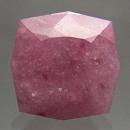|
Click on a letter above to view the list of gems. |
|
|
|
|
|
|
|
|
Lepidolite
|
|
| | |
| Discovered in 1792; IMA status: Valid (pre-IMA; Grandfathered) | ||
|
| ||
|
Chemistry |
|
|
| |
|
K(Li,Al)3(Si,Al)4O10(F,OH)2 | |
|
|
Potassium Lithium Aluminum Silicate Hydroxide Fluoride |
|
Molecular Weight: |
388.30 gm |
|
Composition: |
Potassium |
10.07 % |
K |
12.13 % |
K2O |
|
|
Lithium |
3.58 % |
Li |
7.70 % |
Li2O |
|
|
Aluminum |
6.95 % |
Al |
13.13 % |
Al2O3 |
|
|
Silicon |
28.93 % |
Si |
61.89 % |
SiO2 |
|
|
Hydrogen |
0.26 % |
H |
2.32 % |
H2O |
|
|
Oxygen |
45.32 % |
O |
|
|
|
|
Fluorine |
4.89 % |
F |
4.89 % |
F |
|
|
|
— % |
F |
—2.06 % |
—O=F2 |
|
|
|
100.00 % |
|
100.00 % |
= TOTAL OXIDE |
|
|
|
||||
|
Classification |
|
|
| |
|
Silicates (Germanates) | |
|
8/H.10-70 | |
|
|
9 : SILICATES (Germanates) |
|
Related to: |
Mica Group. Biotite Subgroup. Muscovite, Phlogopite, Polylithionite-Trilithionite Series |
|
Members of Group: |
Mica Group: Aluminoceladonite, Anandite, Annite, Annite-Phlogopite Series, Aspidolite, Balestraite, Biotite, Bityite, Boromuscovite, Brammallite, Celadonite, Chernykhite, Chromceladonite, Chromphyllite, Clintonite, Eastonite, Ephesite, Ferroaluminoceladonite, Ferroceladonite, Ferrokinoshitalite, Fluorannite, Fluorphlogopite, Ganterite, Glauconite, Hendricksite, Illite, Kinoshitalite, Lepidolite, Luanshiweiite, Margarite, Masutomilite, Montdorite, Muscovite, Muscovite-Celadonite Series, Nanpingite, Natro-glauconite, Norrishite, Oxykinoshitalite, Oxyphlogopite, Paragonite, Phengite, Phlogopite, Polylithionite, Preiswerkite, Roscoelite, Shirokshinite, Shirozulite, Siderophyllite, Sokolovaite, Suhailite, Tainiolite, Tetraferriannite, Tetraferriphlogopite, Tobelite, Trilithionite, Voloshinite, Wonesite, Yangzhumingite, Zinnwaldite |
|
Varieties: |
Cs-rich Lepidolite, Rb-rich Lepidolite |
|
Synonyms: |
Flower Sugilite, Lavenderine, Lilalite, Lilianthite, Lithia Mica, Lithionglimmer, Lithionite |
|
|
|
|
Crystal Data |
|
|
|
|
|
Tabular to prismatic pseudohexagonal crystals, commonly with rounded terminal faces, to 20 cm. In coarse to fine scaly aggregates and massive. |
|
|
Rare, composition plane {001}, twin axis [310] |
|
|
|
|
|
Physical Properties |
|
|
|
|
|
Perfect {001} |
|
|
Uneven |
|
|
Flexible, elastic |
|
|
2.5 - 4.0 |
|
|
2.80 - 2.90 (g/cm3) |
|
|
May fluoresce medium intensity of creamy white to pale yellow; sometimes yellow |
|
|
Barely Detectable; GRapi = 143.68 (Gamma Ray American Petroleum Institute Units) |
|
|
|
|
|
Optical Properties |
|
|
|
|
|
Pink, purple, rose-red, violet-gray, blue, yellowish, white, colorless; colorless to pale pink in thin section |
|
|
Translucent |
|
|
Vitreous, Pearly |
|
|
1.525 - 1.587 Biaxial ( - ) |
|
|
0.0290 - 0.0380 |
|
|
Weak; r > v |
|
|
X = almost colorless; Y = Z = pink, pale violet |
|
|
|
|
|
Occurances |
|
|
|
|
|
Geological Setting: |
In granite pegmatites, derived by metasomatic replacement of muscovite or biotite; in some high-temperature quartz veins, greisens, and granites. |
|
Common Associations: |
Spodumene, Elbaite, Amblygonite, Columbite, Cassiterite, Topaz, Beryl, Micas |
|
Type Locality: |
Rožná pegmatite, Ždár nad Sázavou, Vysocina Region, Moravia (Mähren; Maehren), Czech Republic |
|
Year Discovered: |
1792 |
|
View mineral photos: | |
|
|
|
|
More Information |
|
|
|
|
|
| |
|
|
|
|
Lepidolite is an uncommon mica and is an ore of lithium that forms in huge masses that can contain substantial amounts of lithium. Its typical pink to violet colors are one of the only field tests to identify Lepidolite from other micas although pink Muscovite or very pale Lepidolite may complicate identification. Lepidolite
is available from Rozná, near Bystrice, Czech Republic;
from Alabashka, Ural Mountains, Russia. In the Varuträsk
pegmatite, 15 km northwest of Skellefteĺ, Västerbotten,
Sweden. In the USA, at Mt. Mica, near Paris, Oxford
County, and Auburn, Androscoggin County, Maine; in the
Mesa Grande and Pala districts, San Diego County, California;
from the Brown Derby pegmatite, Gunnison County, Colorado;
in the Ingersoll mine, near Keystone, Pennington County,
South Dakota. From the Tanco mine, Bernic Lake, Manitoba,
Canada. At Maharitra, Mt. Bity, Madagascar. From Bikita,
Zimbabwe. In India, at Hazaribagh, Bihar. From the Virgem
da Lapa pegmatite, Minas Gerais, Brazil. |
|
|
We
have not photographed our Lepidolite gems. Please
check back soon. |
